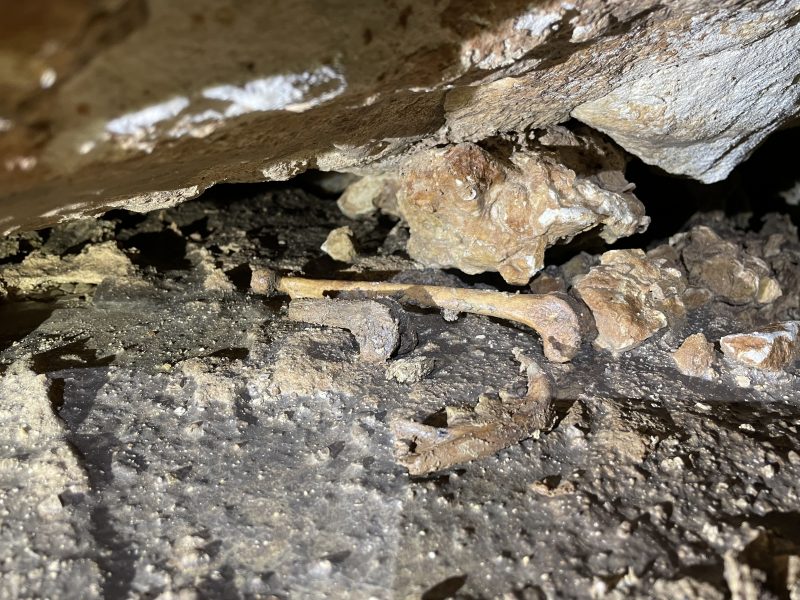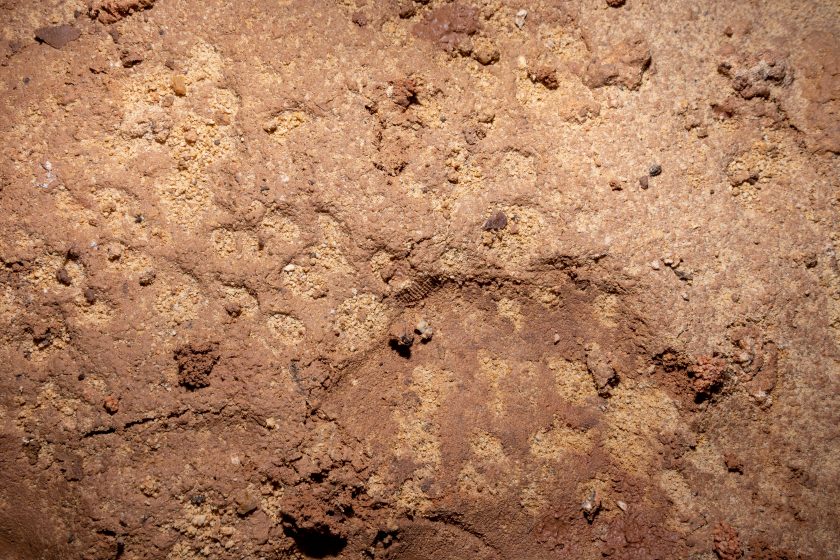UT Paleontologists Collecting Ancient Cat Fossils from Natural Bridge Caverns
December 16, 2022

In January, paleontologists from The University of Texas at Austin will be heading deep within areas of Natural Bridge Caverns that are not accessible to the public to collect a cache of ancient wildcat fossils that could help researchers learn more about wild Texas felines – which are rare and mysterious in both the prehistoric past and present.
The scientists don’t know yet what species the cat fossils are from. They do know they were small – about the size of today’s domestic cats, according to John Moretti, a doctoral student at the UT Jackson School of Geosciences who is leading the fossil collection effort.
Moretti said that the cat tracks on the floor of a cavern chamber immediately brought to mind his own cats creeping around the cave.
“They’re cute little paw prints that get your imagination going,” he said.
Cats are solitary creatures, which makes them rare fossil finds. The cats of Natural Bridge Caverns can help scientists learn more about the diversity, distribution and behavior of wild cats that once roamed prehistoric Texas, and how the ancient felines compare to wildcat species living today.
Natural Bridge Caverns is located about 55 miles southwest of Austin and is a popular tourist destination visited by hundreds of thousands of guests every year. The largest commercial cave in Texas, roughly 20% of the cavern system has been lit and paved for educational public tours. The remaining area is “wild cave,” accessible only by experienced cave explorers or adventure tours.
The wildcat bones and tracks were found in 2019-2022 by the Natural Bridge Caverns caving team and scientists one mile from the entrance in three locations: a tight and muddy passageway called Discovery Crawl, and in two deep pits emptying into large chambers called The Dungeon and the Inferno Room. Each location contains the remains of at least one cat.
The Dungeon and the Inferno Room are entered by rappelling down 65-foot and 50-foot vertical drops that appear as holes in an overlying cave passageway. The cat tracks are located in this passageway – just before each drop to the chambers where the bones are found. Their placement suggests that the cats in the Dungeon and the Inferno room may have met their end by falling in.
“The cave is so utterly dark, and the openings are so precipitous and funnel-like that if you don’t know that the holes are there it is inevitable that you will fall in,” Moretti said.
The researchers will investigate whether the cat remains in the chambers can be matched to the prints.

The cat bones in both chambers are estimated to be up to 20,000 years old and are embedded in cave formations. The paw prints are covered in a soil crust that suggests they are similarly ancient. In contrast, the remains in Discovery Crawl are likely much younger. Other bones discovered in the crawl date back to the 1950s.
Reaching the cat remains will require careful maneuvering on the researchers’ part. Moretti has been training for months so he can safely navigate the vertical drops into the Dungeon and the Inferno Room. Discovery Crawl consists of a long, narrow passageway, requiring the researchers to scoot and inch their way to the bones.
Once the bones are back at the UT collections, the researchers plan to conduct a thorough analysis so they can determine their age and identity. Small cat species are anatomically similar, which makes them difficult to tell apart based on bones alone. The team will attempt to extract DNA from the fossils and sequence it so they can definitively determine what types of wildcats the bones belong to. There’s a number of potential options – from bobcats, to margays, to jaguarundis.
The researchers will also see if the bones recovered from the Dungeon match up with a nearly complete ancient wildcat skeleton — which has tentatively been identified as a bobcat or a margay — that was collected from the chamber by a former UT graduate student in 1963 and has been in the UT collections ever since. According to Moretti, the chances look good. The bones he has seen in the Dungeon appear to be the ones missing from the UT specimen.
“That doesn’t mean they’re the same skeleton, but it really hints at it,” he said.
The team expects to have preliminary findings by fall 2023.
For more information, contact: Anton Caputo, Jackson School of Geosciences, 210-602-2085; Monica Kortsha, Jackson School of Geosciences, 512-471-2241
